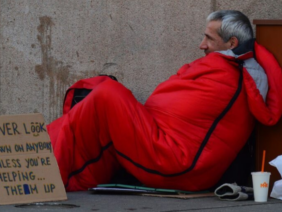
How and when did homelessness start?
By: Kelechi Obasi
Is homelessness always a social problem? Has Canada always had a problem with a lack of adequate housing and shelter for a diverse population? Is the current situation a modern issue caused by a variety of factors such as mental illness, financial insecurity, and domestic violence?
A quick look at the history of “de-housing” in Canada will give you a better idea of how the issue of homelessness came to be.
Origins of Homelessness in Canada
Of course, the term “homelessness” has most likely been in the English lexicon for more than two centuries, but it was rarely used to describe a social issue. In fact, a search of the New York Times historical database for news published between 1851 and 2005 revealed that the term “homelessness” was used in 4,755 articles. What is interesting, however, is that 87 percent of these articles used this term most prominently between 1985 and 2005.
Prior to the mid-1980s, the term “homelessness” did not refer to a social problem in Canada, even during the Great Depression and World War II. In any developed society, there have always been those who, for a variety of reasons, cannot afford the convenience of a fixed address.
However, various government policies and support mechanisms were in place to meet the majority of the need. There were also a few charitable organizations that stepped up to fill the gaps by providing some form of shelter. As a result, the majority of the population was housed, even if those housing conditions were temporary, in poor condition, and only provided a place for shelter.
The terms ‘transient’ and ‘unhoused’ were commonly used to describe people in those days, who happened to be mostly men. They were referred to as “homeless” on occasion because they had few to no identifiable group or family ties and lacked the economic and social support that comes with group and family relationships. These men found temporary refuge in places like Salvation Army rooming houses. In some ways, they were unhoused rather than homeless.
Destitute women soon joined the ranks of those living rough and even on the streets. The term “homelessness” was coined to emphasize that these women, whether housed or unhoused, fell outside of the gendered norms associated with home.
According to Aileen Ross, a McGill Sociology Professor, “homemaking has always been thought of as a much more important part of a woman’s identity than a man’s… The majority of the women had lost this aspect of their identity.”
Homelessness in the 21st Century
Almost every urban centre’s streets are littered with Canadians who have only the starry night sky as a roof over their heads. This tribe’s vulnerable members include teenagers and other young people facing stigma because of their sexual orientation, fleeing sexual abuse and violence, single adult men, people dealing with mental health issues or addictions, women fleeing domestic abuse and violence with children, and Indigenous people.
According to an August 2021 report on Youth Homelessness in Canada, 20% of the country’s homeless population is between the ages of 13 and 24. That is a staggering number at 35,000 to 40,000 young people.
The federal government had a history of trying to address the issue of homelessness by investing remarkably in adequate housing for Canadians back in the 1960s and 1970s. A rejig of the National Housing Act in 1973 spurred the construction of 20,000 units of sufficient housing every year until the mid-1980s, when a growing number of people who were previously housed in these prosperous countries were no longer housed. Like many other affluent nations around the world, Canada’s de-housing predicament was set in motion.
Those who are homeless may experience the situation for varying lengths of time and under various conditions. According to the Canadian Observatory on Homelessness, such people can fall into one of four categories: unsheltered, emergency sheltered, provisionally housed, or at risk of homelessness.
Those in the unsheltered homeless category are considered “absolutely homeless and living on the streets or in places not intended for human habitation.” These can include:
- Temporary use of public spaces such as sidewalks, squares, parks, and forests.
- Living in cars, garages, attics, or closets.
- Makeshift shelters made from salvaged materials (such as cardboard or tarps).
- Living in shacks or tents
- Squatting in either a private property or vacant buildings.
The Longterm Effects of Homelessness
The lack of continuity in the government’s resolve to provide adequate housing units in the 1980s and beyond became a catalyst for the onslaught of homelessness in Canada. Very little to no attention was paid to providing housing to a now burgeoning population, and like a thief in the night, the crisis crept in and has since taken hold. As a result, the situation is now approaching critical condition status.
The fallout of this situation is undoubtedly scary. On one hand, it has a huge impact on society’s justice system as homeless people tend to be more criminalized in today’s society. On the other hand, they are more than likely to be victims of crimes which range from robbery, to sexual abuse, and even murder. Critics of the government’s position on enforcement rather than rehabilitation and support are loudest in their complaints about the highhandedness of enforcement officials in their treatment of the homeless.
Additionally, the health ramifications are a sore point for many others. They highlight the long-term deleterious effects of the scourge of homelessness on the physical, emotional, and mental health of those individuals who have or are currently experiencing it.
Final Thoughts
Beyond these warning signs, it is equally important to understand that there needs to be general public reorientation on the homelessness issue. Today, even though no one wishes homelessness on any other individual, society’s attitude towards and subhuman treatment of those caught in the web of homelessness plays a major role in how the problem is approached in our world. While the government has a big part to play in the rise of this issue, exercising compassion and respect for those experiencing homelessness can go a long way in our culture and perhaps even change the narrative for the better.




